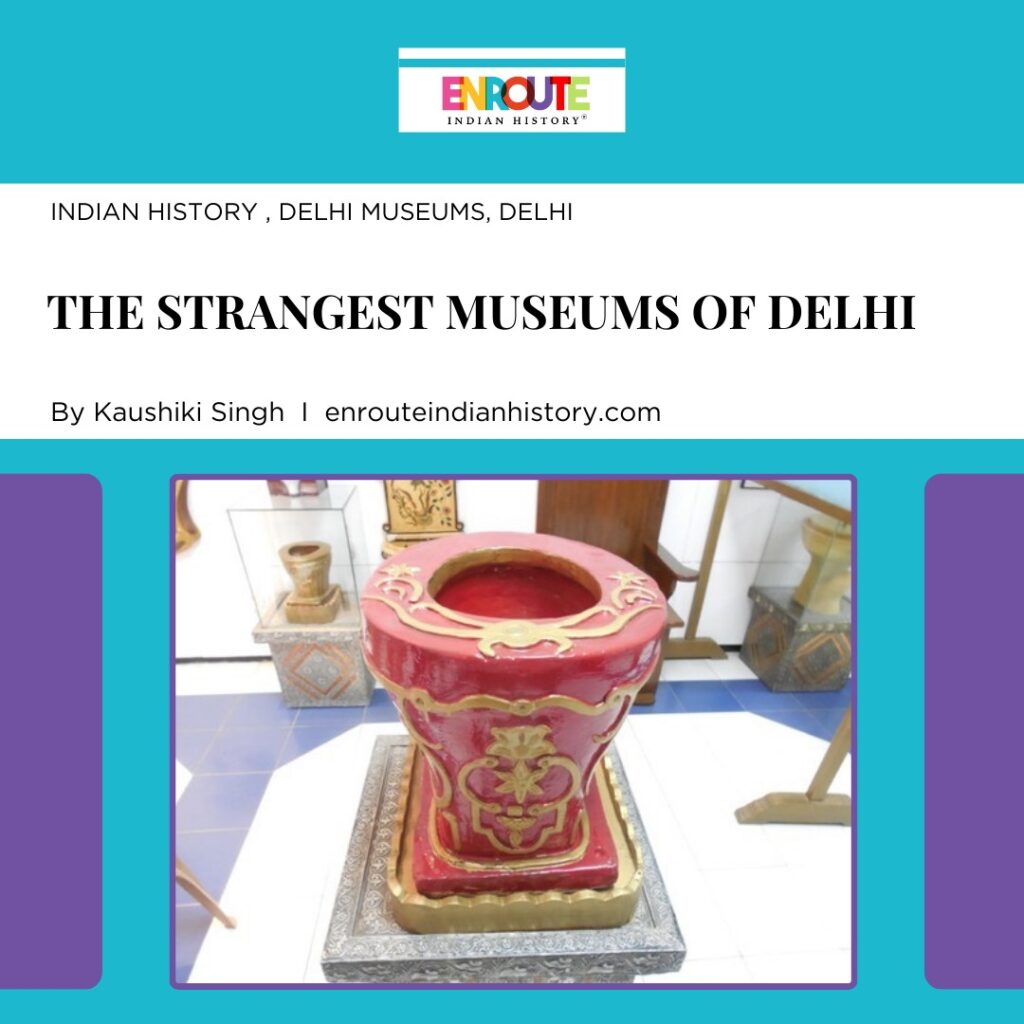
Visiting a museum on a picnic during our school time is one of the most cherished memories we have. It is rightly said that a museum is the bridge that connects past, present and future. It is actually a gateway to another time, could be of an era which has now become a history or could be something of the future. Museums are the best way where one can deep-dive into the past events and understand the rich history of the land where they are now living. They contain many artefacts and objects of historical, artistic, cultural and scientific interests.
Delhi being a historical city, has many renowned museums attracting visitors all over the world. There are many types of museums in the city, most famously National Museum of India, Crafts museum, National science centre museum, National Gallery of Modern art (NGMA), National Rail Museum and many others. The above-mentioned museums need no introduction because of their wide popularity among the people and also because of the exotic things they offer for display. For example, the famous National museum of Delhi has around 2,10,000 artefacts, starting from the Harappan period. Similarly NGMA has more than 17,000 works of 200 plus renowned artists from all over the world.
But it is equally important to understand that there are many other prominent museums in Delhi itself that are of great significance, pouring knowledge but are less-known among individuals. So let’s explore some unconventional museums of Delhi that are equally exciting.
SHANKAR’S INTERNATIONAL DOLL MUSEUM

(Source- Delhi Tourism; Shankar’s international doll museum of Delhi)
Who doesn’t love dolls right? In our childhood, in some or the other, we have these sweet memories where we used to play with dolls. Not just playing, but dolls are also used as a decorative item at our home. So imagine going to a place where everything you see are dolls of all forms. Situated on the Bahadur Shah Zafar Marg of New Delhi in the building that houses the Children’s book trust, the museum has one of the largest collections of costume dolls anywhere in the world.
The doll museum was set up by the efforts of a renowned politician cartoonist, K. Shankar Pillai. In the 1950s, Pillai was given one Hungarian doll by the then Hungarian Ambassador to India. This was the moment which induced him the idea to make bigger collections of dolls and from then, wherever he travelled, collected a doll of that region. The museum was completed in 1965 and was inaugurated by the then president of India, Dr. S. Radhakrishnan. Inside the museum, one would encounter around 160 glass cases which are 1000 feet long, mounted on the walls showing exhibits from European countries, U.K., USA, Australia, New Zealand, Commonwealth of independent states, Asian countries, the Middle East, African nations and India. There is also a representative collection from the over 150 kinds of authentic Indian costume dolls made at the Dolls Workshop attached to the Museum.
The International doll museum currently has nearly 7000 exhibits from over 85 countries. The museum is visited by children, adults, teachers, students and even attracts foreigners, teaching them about art, culture and costumes of different nations.

(Source- Tour My India; Different dolls representing different countries of the world)
Location- Bahadur Shah Zafar Marg, New Delhi
NATIONAL PHILATELIC MUSEUM

(Source- GPSmyCity; National Philatelic museum of New delhi)
Many of us are die-heart fans of collecting different postal stamps of different regions. It’s actually a popular hobby. So imagine a place where these stamp lovers actually get to see various postal stamps, for them National Philatelic museum is the perfect spot. Philately basically refers to the collection and study of postage stamps and this museum is actually a unique initiative taken by the Indian Government postal service. The idea behind is to reflect the rich postal heritage of our nation and also to promote this interesting hobby among children as well as adults.
The Museum is located in the Dak Bhawan, Sardar Patek Chowk of New Delhi, showcases an exotic display of stamps, right from the very first stamp issues in India (issued Sindh Dak in 1854) along with many other rare stamps which were issued before India’s independence by then Princely states. One will also find many thematic stamps based on wildlife, flora, science and technology, famous personalities, armed forces etc. Nashik is one of the most famous stamps on the display issued by the Army postal service and India security press. Besides many Indian stamps, the museum also has different postage stamps from all over the world and also has an amphitheatre for holding events on philately. The department also has a special artist corner that shows the process of designing stamps.

(Source- Earth Trip; Stamp collection in the national Philatelic museum)
Location – Dak bhawan, Sardar patel Chowk, New Delhi
SULABH INTERNATIONAL MUSEUMS OF DELHI.

(Source- Viator; Sulabh international museum of delhi)
Going to a place where all you see are toilet seats might seem very unusual. The main reason behind this is that unlike other body functions like eating, drinking, sleeping, dancing etc, defection is still considered very lowly. In India itself, toilets are touchy issues where earlier, around 70% of our population practised open defecation due to poverty and their belief that toilets inside the home are unclean. But the fact that no one can deny is that toilets are essential for human hygiene and form a significant aspect of human civilization, right from historic times. The founder of Sulabh international museum of Delhi, Dr. Bhindeshwar Pathak said, “The idea was to start a healthy conversation about sanitation and toilets. We wanted to tell people toilet is not a dirty word.”
Situated in the Mahavir enclave of New Delhi, the museum has a collection of pictures, objects and facts detailing the historic evolution of toilets from 2500 BCE to the present date. Also shown are the chronological developments relating to technology, social customs related to toilets, toilet etiquette, prevailing sanitary conditions and legislative efforts of that time. One will find an explicit display of privies, chamber-pots, toilet furniture, bidets and water closets from 1145 CE to the present time. The museum has 3 main sections. First section is for the ancient period that starts with the depiction of sanitation arrangements during the Harappan period for example, wet toilets at Mohenjodaro and underground drain section at Dholavira. Not only focusing on India, but the museum also displays sanitation of other ancient civilizations like Egypt, Babylon, Crete, Jerusalem etc.
Another section is related to the medieval times where it displays toilets of Amber fort in Jaipur, Akbar’s Fort in Fatehpur Sikri, Golconda fort of Hyderabad etc. One would also encounter the table-top toilet of England, decorated commodes from Auria and other cross-stools prevalent in Europe during that period. Finally comes the modern section that has interesting toilet-related cartoons, jokes and photos of toilets from the catalogues of reputed sanitary ware manufacturing companies and public toilets of different countries. This section also shows some ultra-modern electronic toilets from countries like Japan, South Korea and many more.

(Source- Gulf News; a medieval toilet at Sulabh international museum)
Location- Mahavir Enclave, New Delhi
GHALIB ACADEMY

(Source- India.com ; Mirza Ghalib museum in New Delhi)
Mirza Ghalib Museum, also known as Ghalib academy located in the vicinity of the tomb of the sufi saint Hazrat Khwaja Nizamuddin, is based on the life-events of the famous 18th century Urdu poet Mirza Ghalib. The museum was formally declared open by the then President Dr. Zahir Hussain on the occasion of Ghalib centenary on February 22nd, 1969.
The museum will surely take one to the era of sher and shayaris and introduce visitors to the finest creations of Mirza Ghalib. The museum has different sections, mainly an auditorium, museum, library, an art gallery and a calligraphy training centre. In these different sections are present arts and artefacts related to Ghalib, photographs of Ghalib’s residents, his attire, food habits, statues, books and other significant documents. The library has an assortment of finest poems of many famous poets, one of them being Mirza Ghalib. In the auditorium, are held events that host gatherings of prominent urdu poets and the museum also has a specific court or darbar of Bahadur Shah Zafar, the last Mughal emperor. A special storehouse is present depicting Ghalib’s favourite foods like Shahi kofta, murgh musallam and jalebi with his plate and glass tumbler.

(Source- Tour My India; Ghalib’s statues and his clothing in the Mirza Ghalib museum of Delhi)
Location – Nizamuddin west, New Delhi.
Though mentioned here are only 4 museums, the list is long. Delhi has hidden wonders in it that need to be explored for the better experience and knowledge of the city as well as of India. These unconventional spots will surely leave anyone amaze and will shower abundance of new ideas to the public. After exploring such museums, we understand how certain things that we tend to ignore or just find very normal add value to our life. Let’s understand this with an example of a doll museum and Sulabh international museum. Who knew that a simple doll that children play with would actually help them to understand the culture of the region from where they are manufactured in the form of clothing, physical appearance and accessories used to decorate the doll. Similarly, a proper toilet is the basic need of humans. But how interesting it is that even toilets that we see today have evolved a lot from the past and have been made more suitable in order to ensure proper hygiene and have well-connected drainage. Without understanding what type of toilet system was prevailing in the past, it’s impossible to make improvements in it to meet the present need. Therefore visiting such places becomes important.
REFERENCE
- delhitourism.gov.in/delhitourism/entertainment/museum_in_delhi.jsp
- delhiwalks.in/delhis-hidden-museums/
- www.childrensbooktrust.com/dollsmuseum.html
- so.city/delhi/article/a-paradise-for-die-hard-stamp-collectors-have-you-been-to-the-national-philatelic-museum
- www.sulabhtoiletmuseum.org/about-us/introduction-to-museum/
- dmsoutheast.delhi.gov.in/tourist-place/ghalib-museum-new-delhi/
- May 15, 2024
- 6 Min Read

























